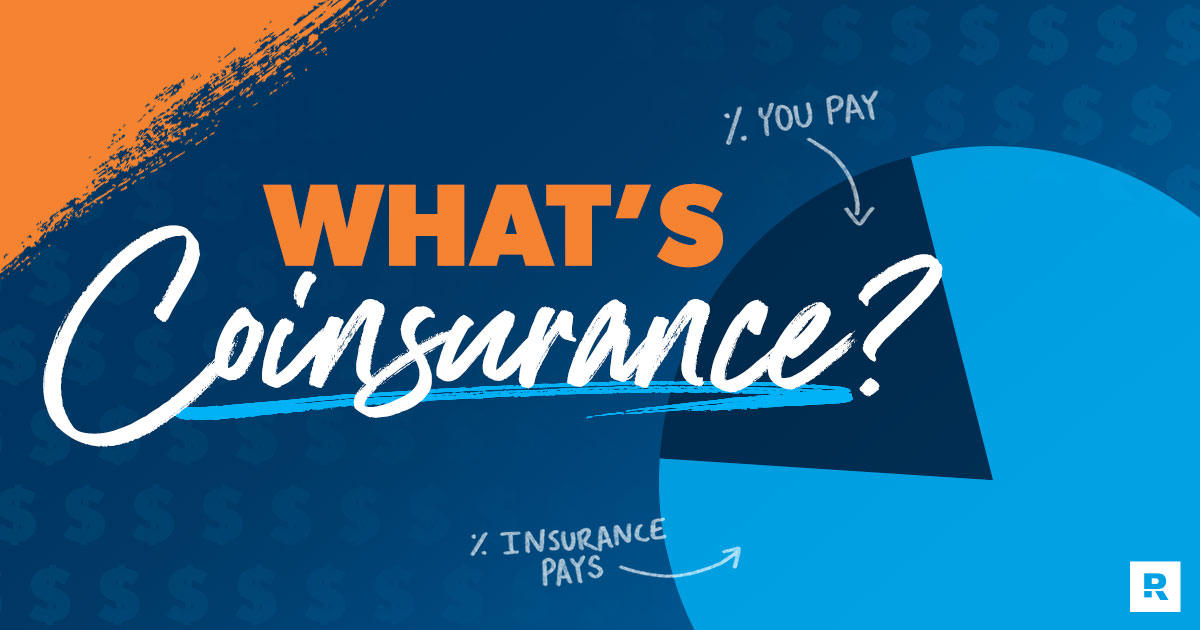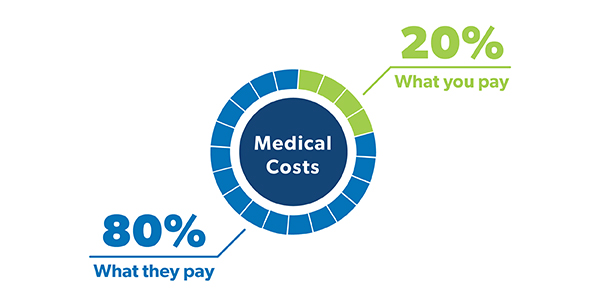
Key Takeaways
- Coinsurance is the percentage of health care costs you pay after meeting your deductible. For example, in an 80/20 plan, your insurance covers 80% and you pay 20%.
- Plans with higher coinsurance percentages typically have lower monthly premiums but result in higher out-of-pocket costs when you need medical care.
- Coinsurance payments continue until you reach your out-of-pocket maximum, at which point your insurance covers 100% of eligible medical expenses for the rest of the policy period.
Health insurance is complicated. We get that.
One of the most common questions we hear from people who are trying to understand health insurance jargon and all the different cost factors is, “What does coinsurance mean?”
If you’re one of those puzzled folks or if you just need a refresher, don’t worry—we’ll make it simple.
What Does Coinsurance Mean?
In the simplest terms, coinsurance is the percentage of health care services you’re responsible for paying after you’ve hit your deductible for the year. With coinsurance, you’re splitting the cost of medical services with your health insurance until you reach your out-of-pocket maximum.
In the simplest terms, coinsurance is the percentage of health care services you’re responsible for paying after you’ve hit your deductible for the year.
When you look at your policy, you’ll see your coinsurance shown as a fraction—something like 80/20 or 70/30. Most folks are used to having a standard 80/20 coinsurance policy, which means you’re responsible for 20% of your medical expenses, and your health insurance will handle the remaining 80%. This is your coinsurance after you reach your deductible.
Now, it’s important to remember that your coinsurance ratio directly affects your monthly premium. Here’s how it works: health plans with higher coinsurance usually have lower monthly premiums. That’s because you’re taking on more risk. So you’ll find that most health plans with 70/30 coinsurance have lower premiums than an 80/20 plan.
So, if you’re mostly healthy and have a good emergency fund in place, it might be a good idea to look for a health plan with higher coinsurance.

How Does Coinsurance Work?
Okay, to fully understand coinsurance, it may help to think of how you pay for health care expenses in phases. How much you’ll pay depends on what phase you’re in.
Phase 1: The Deductible Phase
Before your insurance kicks in, you’re going to have to pay for all of your medical costs until you hit your deductible. So, if you have an insurance policy with a $1,000 deductible, that’s how much you’ll spend on medical expenses before you get help from insurance.
That’s why it’s important to have enough money in savings to cover your deductible if you need to. Having a fully funded emergency fund or consistently putting money into a health savings account (HSA) if you have one could help you cover health costs during this deductible phase.
One way to remember how deductibles and coinsurance work together is to memorize this phrase: “coinsurance after deductible.” That way, you’ll always remember that coinsurance doesn’t start until after you meet your deductible. Once you hit that deductible, you’ll enter the next phase. Which is . . .
Phase 2: The Coinsurance Phase
Here comes the cavalry! At this point, your health insurance will come in and help you pay for a big chunk of your health expenses for the rest of the year while you pay your coinsurance rate.
Let’s say you’ve already hit your deductible earlier in the year and, during a flag football game this month, you take that “break a leg” advice a little too literally. Ouch.
After a trip to the emergency room, you get an X-ray and they put a cast on your broken leg. After all the treatment, the total cost of all the new health services received is $2,500.
If you have an 80/20 coinsurance plan, that means you’ll be responsible for $500, and your health insurance will take care of the rest. Whew!
You’ll keep paying your coinsurance rate of medical expenses for the year until you reach your out-of-pocket maximum. Which brings us to the last phase . . .
Phase 3: The Out-of-Pocket Maximum Phase
Praise hands! Once you hit your out-of-pocket maximum, you’re done. Your insurance plan will pay for 100% of the rest of your medical expenses for the year, and all you have to do is keep paying your premiums. The maximum limits set for health plans in 2021 are $8,550 for individuals and $17,100 for families.1
Remember that your deductible and the three phases we just walked through reset each year, so make sure you consider that with any needed treatments.
Coinsurance vs Copays: What’s the Difference?
You’ve probably also heard the term copay thrown around while you’re shopping for health insurance during open enrollment.
Like coinsurance, copays (or copayments) are just another way health plans split medical costs between you and your health insurer. But there are some differences.
Instead of paying a percentage of your medical expenses, copays are a flat fee for health services like doctor’s visits, prescription medications and trips to the emergency room. Your health insurance plan sets those copay fees for different types of health services.
Let’s say you get sick, take a trip to your doctor’s office, and the cost of the visit is $150. If you have a $50 copay for doctor’s visits, that’s how much you’ll pay—and your health insurance pays for the other $100. With an 80/20 coinsurance plan, you’d pay $30 for the visit ($30 is 20% of $150). In this case, coinsurance is better.
But then, two weeks later, you need to go to the emergency room and, this time, you get hit with a $2,000 price tag. With a $250 copay for emergency room visits, that’s how much you’ll owe. With 20% coinsurance, your share of the cost is $400. In this case, copay is better.
So, which is better overall: Coinsurance or copays? It really all depends on a number of different factors—including your family’s overall health needs, how much the premiums cost, and how much you anticipate spending on medical care in any given year.
Like we said: Things can get super confusing when we’re talking about coinsurance and copays and how much you’ll owe for what. So, make sure you review your health plan at least once a year and be aware of exactly what kind of cost-sharing is included in your policy. That way, you don’t suffer a case of sticker shock when your medical bills come in.
Work With a Health Insurance Expert
Still asking yourself, What does coinsurance mean? An independent health insurance agent can show you how your coinsurance affects your overall health care costs and help you review and compare your health care plan options.
Our friends at Health Trust Financial make it super easy to find a quality health insurance expert who will look out for your best interests. They've been serving Ramsey fans for over 20 years. One of their independent agents can guide you through the process and help you pick the right coverage for you and your family.
Next Steps
- Learn more about how health insurance works.
- Dig into the nitty-gritty and learn about deductibles.
- Learn how to file a health insurance claim.
- Read up on the different kinds of health insurance plans and how to compare them.
- Connect with Health Trust Financial and talk to an agent to find the best health insurance plan for you.
Interested in learning more about health insurance?
Sign up to receive helpful guidance and tools.


